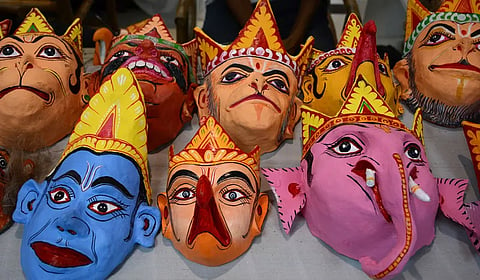
- Home
- Live Blog
- Breaking News
- Top Headlines
- Cities
- NE News
- Sentinel Media
- Sports
- Education
- Jobs

Staff Reporter
Guwahati: The traditional mask-making and manuscript painting of Majuli have been awarded Geographical Indication (GI) tags by the Government of India, attesting to the unique characteristics of the twin crafts.
This will help take this unique craft and art to the world at large and make the river island of Majuli, which is known for its Vaishnavite monasteries, or Xatras, more famous.
Mask-making in Majuli is known to date back to medieval times, after it was introduced by Neo-Vaishnavite saint Mahapurush Srimanta Sankardeva.
The unique manuscript paintings in Majuli mainly depict stories from the Hindu mythological epics Ramayana, Mahabharata, and the Bhagavata Purana. These paintings primarily focus on events related to Lord Krishna.
The twin arts and crafts of mask-making and manuscript painting have now earned the Geographical Indication (GI) tag. The coveted recognition comes after several stages of rigorous evaluation regarding the unique characteristics of the art and craft.
Mask-making, or Mukha Shilpa, as it is called in Assamese, is a craft that is deeply ingrained in Majuli’s culture. The intricately created masks are used in depicting mythological tales of good triumphing over evil, namely, Krishna vanquishing Kaliya, Putana, Bakasura, and Kamsa, or Rama trumping Kumbhakarna, Maricha, and Ravana.
The art of mask-making is one of the most unique creations of Mahapurush Srimanta Sankardeva, which became a traditional folk art of Assam. Masks first became a part of Bhaona performances in the 15th century. A bhaona is an opera-style play based on mythological characters and stories.
Traditionally, masks are divided into three types:
Barmukha, or Great Mask: These masks are made in two parts—part of the torso and part of the head. The performer wears both torso and head parts during the act. This kind of mask is at least 10–12 feet high and is hence called Barmukha.
Lotokari Mukha, or Hanging Mask: These masks are smaller than Barmukha, but the torso and head parts are made in the same way as Barmukhas. The only difference is that the head mask is flexible, making it easier for the artiste to move his head and body. Examples are Putana, Taraka, Maricha, Subahu, etc.
Mukh Mukha, or Face Mask: This mask covers only the performer’s face, while the rest of the body is decorated with attractive costumes that match the mask. Since they supplement the dress, these masks are also said to be ornamental.
The masks are produced locally, using materials like bamboo, cane, cotton cloth, cow dung, clay, cork, jute, and others. Mask makers have been traditionally using natural colours and dyes, such as tree seeds, bark, leaves, bael sap, wheat plant sap, and other traditionally-used minerals such as vermilion, yellow orpiment, mustard-oil lamp ash, and indigo, to impart vibrant colours to the masks.
Also Read: Master Mask Maker Hem Chandra Goswami Named for Padma Shri
Also Watch: